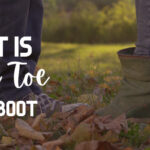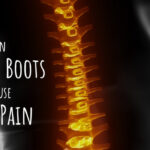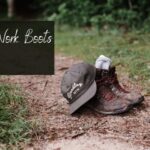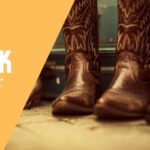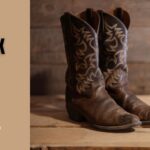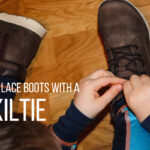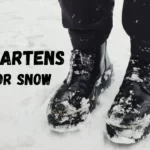Last Updated on September 1, 2023
Purchasing a new pair of boots can lead you down a rabbit hole of bewildering terms. As someone who has delved deep into the world of boots, I’ve compiled an extensive list of boot anatomy components. Additionally, I’ve included 40 plus boot-related terms that might cross your path. While you may not need to grasp all of these details to buy boots, if you share my passion for boots, you’ll appreciate delving into this comprehensive list.
Anatomy of a Boot: 42 Boot Components Explained
Backstay: Reinforcing the Heel: The backstay, or heel counter, is a leather strip connecting the two halves of a boot at the back. It imparts shape and structure to the heel, ensuring stability and support.
Collar: Comfort Around the Ankle: The padded or cushioned collar encircles the boot’s top, offering ankle comfort and support. It needn’t always be padded; rolled leather can serve the purpose too.
Counter: Shaping the Heel: A strip of leather shaping the heel and providing structure.
Eyelets: Secure Lacing: Metal or plastic loops through which laces are threaded, with metal being the more durable choice.
Gemming: Stabilizing the Upper: A fabric strip glued into the waist of the boot to maintain upper stability.
Heel: Elevating Your Style: The raised rear part of the sole. Heels are often made of stacked leather or rubber, combining style and functionality.
Heel Lift: Top Lift for Durability: Also known as the top lift or heel cap, this rubber “cap” sits at the bottom of the boot’s heel.
Heel Rand: Additional Reinforcement: A strip of leather or metal between the heel counter and sole, found in certain cowboy boots for enhanced durability.
Insole: Comfort Underfoot: A layer inside the boot providing foot comfort, either removable or fixed. Traditional brands use leather, while newer ones opt for high-density foams.
Lacing: Securing the Fit: The cords used for securing and adjusting the fit of the boot. Discover various laces like woven nylon, leather, or cotton for optimal comfort and style..
Lining: Inner Comfort: The material covering the boot’s interior, available in leather or fabric, influencing comfort and breathability.
Midsole: Cushioning Layer: A layer, often leather, rubber, or high-density foam, positioned between the insole and outsole for enhanced comfort and shock absorption.
Outsole: Ground Contact and Traction: The bottom of the boot touching the ground, delivering protection and traction. Materials include leather, rubber, and foam.
Pull Tab: Easy Entry: A loop or tab at the boot’s back facilitating easier pulling on of the boot.
Quarter: Back of the Boot: The section covering the back of the foot and ankle, constituting the upper’s rear half.
Speed Hooks: Quick Lacing: Metal hooks at the boot’s top, easing the lacing process.
Shaft: Ankle to Calf Coverage: The boot section enveloping the ankle and calf, available in various heights and styles. While the standard shaft size is around six inches, variations abound. Logger boots, for instance, often boast shafts of eight inches and beyond.
Shank: Arch Support and Structure: A rigid strip in the midsole that stabilizes the arch, commonly made from steel, plastic, or other materials.
Tongue: Moisture Protection: The material beneath the laces, shielding from moisture and preventing lace discomfort.
Top Lift: Enhancing Heel: The rubber part on the back of the heel, also known as the heel cap.
Upper: Leather Components: The leather portions of the boot, excluding the sole and lacing.
Vamp: Front Upper Section: The upper’s front portion, often made of leather.
Welt: Connection Point: A strip sewn around the insole and upper, where the outsole is attached, common in Goodyear welted footwear.
Stitching: Connecting the Components: Stitching is a vital element present in various forms on every boot. The upper involves stitching for attaching the heel counter, different sections of the vamp, and more. In Goodyear welted boots, a stitch secures the welt to connect the outsole. Upper stitching can appear as one, two, three, or occasionally four rows, with five rows rarely seen.
Toe Box: Guarding the Toes: The toe box encompasses and safeguards the toes’ front region. It adopts diverse shapes such as almond, snip, and round toes. I’ll delve into these variations below, but rest assured, every boot features a toe box.
Toe Cap: Added Toe Protection: A fortified layer of leather positioned atop the toe box for additional protection. Some boots incorporate toe caps, while others opt for a simpler design without one.
Padded Collar: A cushioned collar for added ankle comfort and support.
Gusseted Tongue: A tongue attached to the sides to prevent debris and water entry.
Toe Bumper: Reinforced layer on the toe box for durability and protection.
Arch Support: Cushioning or structure in the midsole for foot arch support.
Footbed: An insert offering cushioning and support for the entire foot.
Waterproof Membrane: A layer making the boot waterproof while allowing moisture escape.
Reflective Elements: Materials reflecting light for enhanced visibility.
Lug Pattern: Specific tread arrangement on the outsole for traction.
Ankle Padding: Extra cushioning around the ankle area for comfort.
Steel Shank: A steel strip in the midsole for arch support and puncture prevention.
Pull Loops: Fabric loops aiding in pulling the boots on.
Antimicrobial Lining: Lining treated to prevent bacteria growth and odors.
Heel Counter Reinforcement: Additional reinforcement around the heel counter for stability.
EVA Midsole: Lightweight midsole for cushioning and shock absorption.
Piping: Decorative trim along seams or edges for style enhancement.
Essential Boot Terminology: Unveiling Over 40 Key Terms
Boot Types and Construction
Goodyear Welt Construction: Tradition Meets Durability In this traditional method, the upper and insole of the boot are stitched to a leather welt that runs along the perimeter. This construction allows for easy resoling, contributing to its reputation for exceptional durability and water resistance.
Blake Stitch Construction: Sleek and Streamlined In the Blake stitch method, the insole and outsole are directly stitched together without a welt. This results in a sleek and streamlined appearance, making it particularly suitable for dress boots where a refined look is desired.
Cemented Construction: Glued for Speed Cemented construction involves gluing the upper directly to the outsole, making it a cost-effective and faster method of boot manufacturing. However, this approach tends to offer less durability and limited potential for resoling.
Storm Welt: Elevated Water Resistance A variation of the Goodyear welt construction, the storm welt extends above the upper. This design choice enhances the boot’s water resistance capabilities, making it well-suited for challenging weather conditions.
Board Lasted Construction: Maximum Structure In board lasted construction, the upper is secured to a rigid board placed within the midsole. This design imparts a structured feel to the boot, which can be particularly advantageous for individuals with specific pronation requirements.
Direct Injected Construction: Injection-Molded Durability Direct injected construction involves injecting liquid rubber onto the bottom of the upper, which is then shaped to form the outsole. This method offers slightly better weather resistance compared to cemented construction, making it a viable choice for various environments.
Toe Types: Finding the Right Fit
Toe Types: Finding the Right Fit
Different toe shapes offer various styles and functionalities in boots, catering to diverse preferences.
Almond Toe: Subtle Pointing
The almond toe shape features a gentle taper that gradually narrows towards the tip, providing a refined and slightly pointed appearance. This toe shape is often favored for dress boots and stylish designs, offering a touch of sophistication.
Cap Toe: Reinforced Protection
A cap toe involves an extra layer of material, often leather, that is sewn onto the toe box. This additional layer reinforces the area, enhancing durability and providing added protection against wear and tear.
Carbon Toe: Lightweight Safety
Carbon toes are a lighter alternative to steel toes. They offer both impact resistance and safety without the conductivity of steel, making them suitable for work environments. Additionally, they are less likely to become uncomfortably cold in winter.
Celastic Toe: Structured Style
A celastic toe doesn’t provide safety like a steel toe but reinforces the upper leather around the toe. This reinforcement maintains a structured appearance as the boot breaks in, ensuring durability while retaining style.
Club Toe: Durable Comfort
Similar to a square toe, the club toe shape is rounded at the front. It is a popular choice for work boots that prioritize durability and comfort, ensuring ample space for the toes.
Pointed Toe: Elegantly Edgy
The pointed toe shape boasts a strikingly pointed appearance, adding an edge of elegance to boot designs. Often found in dress boots, this toe shape is well-suited for those seeking a fashion-forward look.
Round Toe: Classic Comfort
Recognized for its timeless appeal, the round toe is wider and rounded at the front, offering ample space and comfort for the toes. This shape is particularly well-suited for work boots that emphasize ease of wear.
Snip Toe: Narrow and Pointed
The snip toe shape is characterized by a narrow, pointed front that tapers to a delicate tip. This design is commonly featured in cowboy boots, contributing to their distinctive appearance.
Square Toe: Bold and Angular
A square toe is characterized by its angular, squared-off front. This bold and contemporary design is popular for both dress boots and boots with a fashion-forward edge. It adds a unique touch to the overall aesthetic.
Steel Toe: Safety Priority
The steel toe shape includes a steel reinforcement that protects the toes from impact or compression hazards. This safety feature is essential for work boots designed to prioritize foot protection in hazardous environments.
Heel Types: Elevating Style and Comfort
The type of heel in a boot contributes to both its style and comfort, offering various benefits for different preferences.
Block Heel: Timeless Versatility
A block heel is a standard, pitchless heel commonly crafted from stacked leather. Renowned for its timeless versatility, this heel style seamlessly complements a wide range of boot designs, making it a popular choice across various occasions.
Logger Heel: Traction on Uneven Terrain
Slightly taller than regular block heels, the logger heel features a concave shape that aids traction on uneven and challenging terrain. This design is particularly advantageous for individuals navigating through outdoor environments where stability is crucial.
Dogger Heel: Riding and Walking Comfort
The dogger heel is engineered for both horseback riding and walking, offering a comfort-focused design. What sets it apart is its relatively gentle angle, providing more stability and support compared to steeper options like Cuban or cowboy heels.
Cuban Heel: Stylish Statement
Characterized by its tapered back and sides, the Cuban heel serves a style-driven purpose. It’s an aesthetically pleasing choice that harks back to traditional cowboy heels. This type of heel enhances the overall appearance of the boot, making a distinctive statement.
Cowboy Heel: Western Aesthetics
Adding to the list, the cowboy heel features a uniquely angled design that is ideal for western-style boots. It has a steep angle and is often taller, aiding in locking into stirrups while horseback riding. This heel type captures the essence of classic cowboy aesthetics.
Cowboy Heel Types: Stepping into Tradition
Traditional Cowboy Heel: Ideal for Riding:
The traditional cowboy heel boasts a tapered design at the back and sides, featuring a steep angle. This design is specifically engineered for horseback riding, as the shape allows the heel to securely lock into stirrups, providing riders with stability and control during equestrian activities.
Roper Heel: Maximum Stability:
The roper heel is characterized by its flat and short profile. This design prioritizes maximum stability and ground contact, making it an optimal choice for individuals seeking enhanced balance and comfort, particularly when walking or standing for extended periods.
Riding Heel: Riding-Specific Design:
Designed with horseback riding in mind, the riding heel features a pronounced taper and additional height compared to traditional cowboy heels. This design caters to the specific needs of riders by providing ample clearance and support when in stirrups.
Walking Heel: Elevated Comfort:
The walking heel strikes a balance between cowboy heels and the roper heel. It offers greater height compared to cowboy heels but with a reduced taper. This design choice enhances comfort during walking and daily activities, ensuring a comfortable and steady stride.
Fowler Heel: Elevated Roper Style:
Expanding upon the roper heel concept, the fowler heel is a slightly taller variation of the standard roper heel. This heightened design provides extra height and structure while retaining the roper heel’s emphasis on stability and comfort.
Pitched Fowler Heel: Subtle Taper:
The pitched fowler heel takes the fowler heel design a step further by incorporating a slight taper. This subtle taper offers a balanced and aesthetically pleasing look while maintaining the foundational characteristics of the fowler heel for stability and support.
Other Boot Terms: Expanding Your Vocabulary
Understanding these lesser-known boot terms can provide deeper insights into the construction and care of your footwear.
Foxing: Outsole Border
Foxing refers to the strip of leather or material that runs along the border between the outsole and the upper. This feature is more commonly found in specific boot constructions, adding an extra layer of durability and protection to the boot’s structure.
Last: Shaping the Upper
A last is a crucial tool in boot manufacturing. It’s a wooden or plastic mold that precisely shapes the upper part of the boot to match a specific foot form. The last ensures consistency in sizing and fit across different pairs of boots.
Lasting: Attaching the Upper
Lasting is the process of attaching the upper part of the boot to the last. During this step, the upper is stretched and shaped around the last to create the desired form of the boot. This process is essential for achieving the boot’s final shape and structure.
Met-Guard: Safety Accessory
A met-guard is a safety accessory that provides protection to the metatarsal bones located in the foot’s midsection. It typically consists of a hardened flap made from materials like carbon fiber and covered with leather. Met-guards are designed to safeguard against impact and compression hazards in hazardous work environments.
Shoe Tree: Preserving Boot Shape
A shoe tree is a tool used to maintain the shape of boots when they’re not being worn. Typically made of cedar, it’s inserted into the boot to help it retain its intended form. In addition to preserving shape, a shoe tree also absorbs excess moisture and helps prevent odors, prolonging the life of your boots.
Welt Stitching: Secure Connection
Welt stitching refers to the process of sewing the welt (a strip of leather) to the upper and insole of the boot. This stitching provides a secure connection that holds the boot’s components together and contributes to the boot’s overall durability and longevity.
Stitchdown Construction: Unique Bond
Stitchdown construction involves stitching the upper directly to the midsole and outsole. This method creates a unique and distinctive look with visible stitching along the outer edge of the sole. It’s known for its flexibility and comfort.
Toe Spring: Upward Curve
Toe spring is the slight upward curve present at the front of the boot’s outsole. It allows for a natural rolling motion of the foot during walking, enhancing comfort and reducing strain.
Pegging: Traditional Method
Pegging is a traditional method of construction where wooden pegs are used to secure the outsole to the upper. While less common today, it’s known for its historic significance in bootmaking.
Saddle: Stylish Accent
The saddle is a separate piece of material, often contrasting in color or texture, that’s stitched onto the vamp of the boot. It’s a decorative detail that adds visual interest and style to the boot’s design.
Toe Bug Stitching: Embellishment
Toe bug stitching refers to decorative stitching patterns on the toe box of the boot. These intricate stitches add a touch of elegance and visual appeal to the design.
Unlocking the World of Boot Anatomy
Prepare to embark on a journey that will elevate your understanding of boot craftsmanship to new heights. Equip yourself with the knowledge that transcends mere terminology – it’s the key to decoding the artistry behind every pair of boots.
With this newfound expertise, you’re armed to face any challenge that puts your boot knowledge to the test. Whether you’re discussing boots with fellow enthusiasts or making an informed purchase, your grasp of boot anatomy will set you apart.
Remember, while boots may come in countless styles, there’s a universal foundation: the upper and the sole. Now, armed with a comprehensive understanding of boot terms, you possess the insights needed to pinpoint the exact shape and style that resonates with your distinct taste.
Step confidently into the realm of boots, where every detail tells a story of design and function. Let your refined understanding of boot anatomy guide you towards the perfect pair, embodying both your personality and practical needs.
As a child, Joey's career spanned a wide range of fields. These include farms, ranches, warehouses, construction sites, etc. Wearing good work boots was essential on all those sites to avoid distractions. As a result of his experience, he can determine which work boots are most appropriate for a particular workplace. Following Joey's work boots, his colleagues and teammates also purchased work boots based on his advice. Therefore, his friends suggested that he start a blog so that he could also help others.


